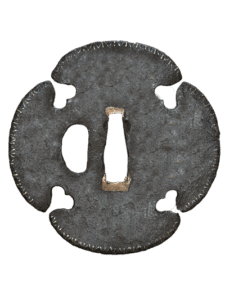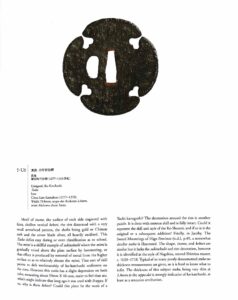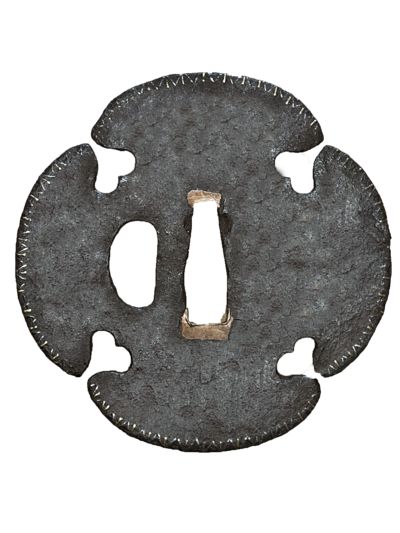
Iron Tsuba with Three-Pronged Elements
-
Attribution: NBTHK Hozon, Ko-Shōami
-
Period: Early Muromachi (1336–1573)
-
Former Collection: Arnold Frenzel
-
Publication: 5th KTK Catalog, 2009
This iron tsuba, defined by its striking three-pronged design motifs, has been awarded NBTHK Hozon papers attributing it to the Ko-Shōami school. The prefix Ko (“old”) distinguishes these earliest works, made during the formative stages of the Shōami tradition in the Muromachi period.
The Shōami family rose to prominence as official metalworkers for the Ashikaga shogunate. Alongside the Gotō and Umetada workshops, they were recognized as one of the three central schools of Japanese metalwork. Their output—both functional and artistic—continued in various branches for more than five centuries.
This example demonstrates the subtle power typical of early Shōami creations. The bold pronged shapes animate the surface while the openwork creates a refined balance of solid iron and empty space. The result is a guard that is at once practical and aesthetically engaging.
Carrying provenance from the Arnold Frenzel Collection and publication in the 5th KTK Catalog (2009), the piece is not only historically important but also firmly documented within modern scholarship
$2,500
(Description from 5th KTK Catalog 2009)
Unsigned, Ko-Katchushi
Tsuba
Iron
Circa: Late Kamakura (1277–1333)
Width 79.8mm, seppa-dai thickness 2.4mm,
mimi thickness about 3mm.
Motif of inome, the surface of each side engraved with faint, shallow vertical kebori, the rim decorated with a very small arrowhead pattern, the shafts being gold or Chinese cash and the arrow blade silver, all heavily oxidized. This Tsuba defies easy dating or even classification as to school. The mimi is a skillful example of sukinokoshi where the mimi is gradually raised above the plate surface by hammering, or that effect is produced by removal of metal from the higher surface so as to relatively elevate the mimi. That sort of skill points to deft workmanship of ko-katchushi craftsmen on the rims. However this tsuba has a slight depression on both sides, measuring about 33mm × 46mm, easier to feel than see, which might indicate that long ago it was used with O-seppa. If so, why is there kebori? Could this piece be the work of a Tachi-kanagushi?
The decoration around the rim is another puzzle. It is done with extreme skill and is fully intact. Could it represent the skill and style of the Ko-Shoami, and if so is it the original or a subsequent addition? Finally, in Jacoby, The Sword Mountings of Higo Province (n.d.), p.49, a somewhat similar tsuba is illustrated. The shape, inome, and kebori are similar but it lacks the sukinokoshi and rim decoration, however it is identified as the style of Nagahisa, second Shimizu master, c. 1620–1710.
Typical of so many poorly documented tsuba, no thickness measurements are given, so it is hard to know what to infer. The thickness of this subject tsuba, being very thin at 2.4mm at the seppa-dai, is strongly indicative of ko-katchushi, at least as a tentative attribution


